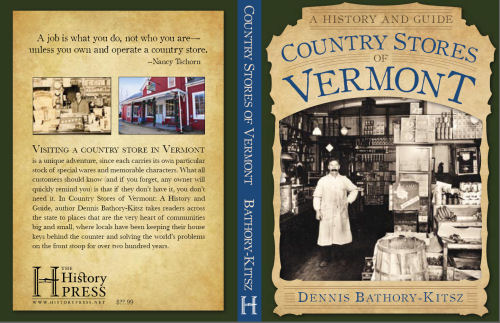A 365-Day Project
"We Are All Mozart"
A project to create
new works and change
the perception of the
music of our time.


 May 16, 2008
May 16, 2008 
The final draft of Country Stores of Vermont: A History and Guide had been submitted on time, on April 15th, as had the photos about a month earlier. With me having filled out an extensive marketing questionnaire and gone through cover discussions, it was on to the process of squeezing 35,000 words of text that included a foreword and acknowledgments, plus 60 photos and their captions, credits, a bibliography, store list, nine maps, and an extensive index, into 256 pages. I had suggested chapter dingbats; they were out. Sidebars couldn't fit in the small format, so they were re-thought as bordered running text. And since I was dealing with a real publisher (the kind with real editors and real house styles), I knew what was coming next: The Edit. In my case, as an experienced author with a consistent style, content editing was not on the list. Nevertheless, editing is a raw experience. Grammatical preferences and linguistic approaches come under scrutiny. Lush prose might be scrubbed, rhythms disturbed, images dulled.
I always read my nearly finished writing aloud, as if it were on a teleprompter. The idea is to learn how the mind-body combination ingests the symbols on the page and turns them into coherent understanding that is re-translated into fluent speech. For example, if the mouth reads over a combination of words and comes up with the wrong sense (the "he saw her duck" situation) or couples the linear elements incorrectly, then either I'm enjoying the ambiguity or the sentence needs some work.
The book went into editing on May 1. Fortunately, the style editing was light: lots of numbers, the de-capitalization of full sentences following colons, and the icky spelling of 'Acknowledgements'. Kind of embarrassing. But that's okay -- house styles are the City Hall of publishing. You can't fight 'em -- even though I did fight for two issues ... and lost both.
Their bibliographic style used ZIP code abbreviations for state abbreviations. Vt. or Vermont became VT, Conn. or Connecticut became CT, Cal. or California became CA. Somewhere in the course of building stylistic rules, the ZIP code abbreviations were incorporated into ordinary writing and especially in lists such as bibliographies. I have fought actively against the trend toward ZIP code abbreviations in texts for years for many reasons, including because they're a machine part of the optical scanning (I don't think of authors or editors as machine parts), they're not immediately clear (quick, what are AR AK AL AB MO MT MB MN MS NV NE NB VT VA VI? would international readers know?), they make an arbitrary federal bureaucratic change to local culture (as when the Post Office also changed the names of all Vermont's "burgh" towns to "burg", now changed back by the towns themselves), and no comma is allowed before or after them (meaning the use of the ZIP code abbreviations with a comma, its typical use in text, is no longer consistent with the postal rule anyway). Beyond that, to use the actual state abbreviations or, better, their full names is to hold onto a certain measure of humanity.
The other issue surrounds the use of commas. For writers and editors, commas are often contentious. Now comma splices are one issue; if I use them, I've made a mistake. But serial commas clarify the speaking rhythms (that's the composer in me talking) and prevent me from reading past the end of a list. In other words, interior 'a and b' combinations are commonplace within lists, so when I don't see a comma before an 'and', my eye groups them as a unit and continues the sentence to the next item or completely jumbles the meaning of what goes with what (that is, "a and b" is grammatically and numerically grouped while "a, and b" is separated and represents a division of the list). The absent serial comma becomes even more serious when long phrases are placed in a series; the concluding comma clarifies that the subsequent words are not part of the ongoing phrase. So without a serial comma I end up retracing the sentence. It happened even when proofing my own draft after the editing. Perhaps this is a problem of insufficient punctuation symbols; semicolon and comma need lighter variants of each, but no one really cottoned to the interrobang, so new symbols sure aren't gonna happen! Having always based my style on the correct spoken rhythm, I write with serial commas in all but the plainest of circumstances.
Before I lose you with a sigh & a who cares, I'll say that the editing took only four days and the commas were the worst of it. Not so shabby.
* * *
In my chronology-heavy story yesterday, I left out some assembly adventures. When creating most historical non-fiction, authors find words organized perfectly by someone else, or content that seems elusive. For this history and guidebook, there were three: maps, a really good poem, and a vanishing road.
Maps are tricky and expensive to draw, and cost a few pennies to license -- but the State of Vermont website had some good ones, nice PDF formats with elements all ready to separate as needed. I followed links to the office, and emailed, then called. They weren't sure. Someone did the maps. I was put in touch with the someone, who sent me to someone else. I ended up at the mapmaker's office, cartoonist Tim Newcomb. I'm going to suspect that Tim is a busy guy, because once he did answer my calls and emails, it devolved into another I'm-not-sure conversation. With the dealine fast approaching, I gave up and used Google Maps for my rough copies. Google does a good job with routes and turns, so the publisher relaxed and put their own graphics department on it. Marhsall kicked butt with the maps, making very clear line drawings.
The really good poem was "The Storekeeper" by Walter Hard. As every good Vermonter knows, Hard was a rock-ribbed Republican with a poetic style to match. Cool and grey and plain-writ, his poems reflected the hardship of Vermont's 1930s and 40s (you'll have to read my book for more!). In our house library was a copy of A Mountain Township, his classic 1933 collection that first appeared in the Rutland Herald; the book was re-published in 1951 by Stephen Daye Press, now very much defunct. The old days of copyright are long gone; the twenty-eight year limit was gone, as was the renewal time. Today texts as old as 1923 remain under copyright, and so I needed permission to use Hard's poem. Hard was long dead, along with most of his family. The Rutland Herald referred me to Susan Allen, who was in charge of rights at the parent Barre-Montpelier Times-Argus. She never answered my calls. (Hey, folks, it's not that I'm unclear -- my requests just don't make these people enough money!) The next stop was the Copyright Clearance Center, which had no record of the Hard book. Eventually Kevin Graffagnino, head of the Vermont Historical Society, recalled that Hard's latter-day publisher was a gentleman named Robert 'Dike' Blair, who had opened the Vermont Book Shop in Middlebury in 1949 and was now retired in northern Vermont. After being carefully vetted, my call was turned over to the 89-year-old Dike, who did indeed own the rights and gave me permission to use the poem. Finding the rights took well over a month.
Finally, there is the vanishing road. During the American Revolution, supplies and troops moved across the independent Commonwealth of Vermont from New Hampshire to Canada via the hidden Bayley-Hazen Military Road. The Bayley-Hazen, the state's first long-distance road, was anecdotally well known and some sections of it were even incorporated into modern roads that ran through Vermont's Northeast Kingdom. Occasional stylistically diverse markers were placed on roads and trails and even in the woods. The words "piece of cake" came unbidden to my mind, too late to stop them. I contacted the division of the state that put up markers. Nope, not them. I wrote to the Vermont Historical Society and the Department of Transportation. Not them either. Did they have a map at least? No. I looked in reference books old and new. Lots of mentions, but no map. The roadside markers guy, though, said that the differing styles of markers suggested they were put up by towns and local societies -- societies gone, town officials departed. The quest was almost given up when Google turned up an odd reference at the Adventure Rider Motorcycle Forum -- a photo trek along parts of the road. I posted. They answered. One recalled a map. A map! But he had forgotten the source -- some Northeast Kingdom agency had made one up about forty years ago. There's not much in the Northeast Kingdom, so I contacted the Northeastern Vermont Development Association and yes, said Shannon Bedor, they had copies of that map ... if I was willing to pay for them. Uh-oh. How much was this going to cost me? $2.54 including postage. And so I was able to create a country store tour along the remaining fragments of the Bayley-Hazen Road.
* * *
The book was edited and about to go into page proofs. Jim Borta emailed. Jim is the owner of the Newfane Store and wanted me to know that the Putney General Store, an important stop in the book, had burned to the ground the night before. We squeezed in the footnote, and I sat down to prepare a talk for the annual meeting of the Vermont Alliance of Independent Country Stores. That's when my editor told me she was leaving the company to return home to freelance, kids at her side. Damn, I hate losing a good editor, especially at the critical final stages.
Could I put my feet up yet? Nope. There was in the interim the premiere of Fanfare:Heat by the Vermont Youth Orchestra on May 4th -- what a hot group! More about that another day because when I got home from my talk at the annual meeting, the cover had been chosen. That was May 8th, and the page proofs arrived on May 9th. Aside from a few slippages and a PC-Mac translation error in the automated indexing (I loathe automated indexing!), some awkward failed indents, and a few photos that could have been more optimally placed, it looked good. Very good. Just ten small errors. Oh, wait. The maps were missing most of the town names! A very cooperative Marshall dropped those in and returned them in the afternoon. Now we got a book!
The next thing I will see is a finished proof copy. Oh yeah bay-bee!
* * *

Cover of the upcoming book. That's Basilio Dente from Barre on the cover, ca. 1920..